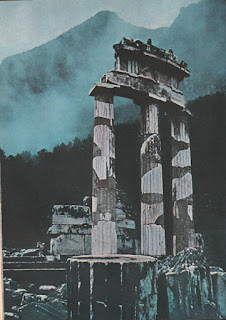Greek Apollo Sun God
With the 6th century BCE we enter the era of the Master Philosophers whose thoughts underpinned two thousand years of Western cultural thinking. This begins the age of the Pre-Socratic Western philosophers of Greece who sought natural rather than mythological explanations of phenomena; Thales (c590BC) Anaximander (c580BC) Anaximenes (c545BC) Heraclitus (c506BC).
The next century will continue the trend in Parmenides (c485BC) Anaxagoras (c465BC) Empedocles (c460BC) Democritus (c430BC) (13).
This current century sees the gradual rise of naturalistic science based on sceptical rationalism and seen to develop through Eleatic rationalism, Ionian Physics and Democritus’ Atomism. (19)
A new cycle of human development is evidenced during this century, inaugurating a new set of human values and development of the mind and soul. It will be followed by five centuries of humanities attempt to adjust to this new level of being. [207]
Temple of Apollo at Delphi
The great cities of Greece along the coast of Asia Minor are in touch with all the leading centres of the civilized world: Egypt, Phoenicia, Lydia, Persia and Babylon. What the Greeks borrowed they transmuted and to this added some of their own thinking. [185]
In the East is the philosophy of Lao-Tse who was born at the end of the previous century but there is indication of his philosophy filtering into the west, probably along the ‘Silk Road’ of trading and even perhaps in the explorers from the west travelling east and then returning with new ways of thinking. Other influences come from India and Asia to meld with those of the west.
598 BCE SOLON (c638-558) Greek Athenian Law maker who is instructed on the mysteries by the priests of Sais in Egypt during a visit there in the time of Pharaoh Amasis I. The priests also told Solon of the story of Atlantis, which he will in turn transmit to Plato (c560 BCE). [72.103] According to Plutarch, Solon received his instructions from the priest Sonchis of Sais. (250)
Egyptian Priest
paying Homage to the gods
c597 BCE NEBUCHADNEZZAR II leads the Babylonians to conquer Jerusalem around this time. With the Assyrian defeat of Egypt, the final fall of the Israelite monarchy is achieved by c586 BCE. Jerusalem and its Temple are destroyed and the Hebrews are exiled to Babylon for 70 years where they are to become scholars of the Babylonian star religion. The Hebrew people are now dispersed as exiles and refugees, going between their homeland, Egypt and Babylon. (102. 9)
The Semitic Chaldeans of Babylon are attributed with the introduction and development of astrology. It is thought that writing and magic were a Turanian or Sumerian (Akkadian) contribution to Babylonian civilization but that astronomy and astrology were Semitic innovations. (1)
The Prophet Ezekiel said ‘I have appointed thee each day for a year’ and astrologers use this as a measurement for prediction by the stars.
591 The capital of Kush [Nubia/Northern Sudan] is moved from Napata to Meroe, by the kings of the 25th Dynasty of Egypt. The Meroe civilization blended Egyptian, Hellenistic and Indian influences into a unique culture, which included their own form of writing, a cursive script that remained undeciphered until the end of the 20th century CE.




No comments:
Post a Comment